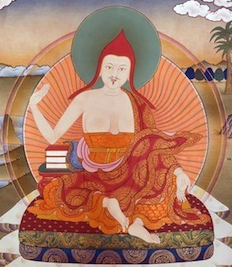Candrakīrti and Two Works Attributed to Him
The figure of Candrakīrti features prominently in the Indo-Tibetan Buddhist philosophical tradition. His work on the Middle Way entitled Entrance to the Middle Way, or Madhyamakāvatāra (དབུ་མ་འཇུག་པ་), is perhaps the most studied work on emptiness and Madhyamaka in the Himalayan world. As a leading exponent of Nāgārjuna’s Middle Way school, and as the foremost champion of Prāsaṅgika Madhyamaka thought, which is seen as the highest philosophical tenet system, Candrakīrti holds a highly elevated position in the Tibetan Buddhist intellectual tradition.
In his Madhyamakāvatāra, Candrakīrti charts out the bodhisattva path in the framework of ten stages and ten perfections, which culminates in the state of the Buddha with enlightenment powers and other marvelous qualities. Of the ten perfections, his work treats in detail the perfection of wisdom by establishing emptiness, which according to him is the true and ultimate nature of all things. It is the full realization of emptiness, or non-self, which constitutes the ultimate knowledge or wisdom and the central path to enlightenment. Candrakīrti employs a wide range of rational reductionist analyses to deconstruct all phenomena to establish the emptiness of all things and in the process refutes the substantialist philosophical claims of both Buddhist and non-Buddhist schools.
While underscoring this nature of emptiness, he rejects the existence of buddha-nature and interprets the sūtras that expound buddha-nature to be provisional teachings which are dispensed merely as expedience to lead beings to enlightenment. He argues that buddha-nature, akin to the notion of self, or ātman, was taught for the sake of helping those inferior beings who are scared of the negation of the self. He cites the Descent into Laṅka Sūtra (Laṅkāvatārasūtra) in his autocommentary on Madhyamakāvatāra to explain that buddha-nature is just another designation for emptiness and the unborn nature of all phenomena. Based on this rejection of buddha-nature in his Madhyamakāvatāra, the followers of and commentators on Candrakīrti considered him to have denied the existence of innate buddha-nature in sentient beings.
However, such one-sided philosophical classification is not as straightforward as it seems and becomes complicated when we consider another work attributed to Candrakīrti and related to buddha-nature. The Pradīpoddyotananāmaṭīkā, or The Extensive Commentary entitled the Illuminating Lamp, is an elaborate commentary on the Guhyasamāja Tantra, which Candrakīrti claims is based on instructions passed down from Nāgārjuna. His mention of Nāgārjuna and citation of the prophecy for Nāgārjuna from The Descent into Laṅka Sūtra in this commentary also generally confirms that Candrakīrti, the author of this commentary, is the same as the Mādhyamika philosopher and author of the Madhyamakāvatāra.
In this commentary on Guhyasamāja, an important inner-yoga tantra, Candrakīrti presents the six hermeneutic tools of the provisional and ultimate teachings, the literal and nonliteral teachings, and the interpretable and the noninterpretable teachings. The treatise also highlights the enlightened state of all phenomena, presenting the five aggregates as five families of buddhas, the five elements as five female buddhas, etc. The text describes the innate nature of the mind as luminous and endowed with enlightened qualities. He argues that sentient beings are the base of all buddhas because they possess buddha-nature (རྒྱལ་བ་ཀུན་གྱི་གནས་ནི་སེམས་ཅན་ཐམས་ཅད་དེ། དེ་བཞིན་གཤེགས་པའི་སྙིང་པོ་ཅན་ཡིན་པའི་ཕྱིར་རོ།།). Thus, we can confidently say that Candrakīrti in the context of the higher tantric school accepted buddha-nature as the essential quality of sentient beings.
Such divergent claims from a single author can be perplexing and can often lead historians to question the identity of the author. The diverging positions of Nāgārjuna on ultimate reality in his scholastic and hymnic corpuses is a good example. While he takes a negative or apophatic approach of reductionism to negate all points of fixation and thus reaches an ultimate truth of utter emptiness in the scholastic corpus, he adopts a positive, cataphatic, and romantic approach to embrace an ineffable absolute reality, or dharmatā, in his hymnic corpus. These two seem contradictory on the surface as does the philosophical position of Candrakīrti on buddha-nature in his two treatises.
Yet, with close scrutiny, one can say that it is an interesting characteristic of the Indo-Tibetan Buddhist philosophical tradition to have philosophers espouse different, sometimes even contradictory, positions in different doxographical contexts. It is a part of their skill-in-means (ཐབས་ལ་མཁས་པ་) and an inclusive strategy to help sentient beings. Such a shift in philosophical stance and interpretation is not seen as a sign of inconsistency and confusion but rather as an intellectual ability to formulate things in the proper context and unravel and propound layers of teachings as per the needs of the different levels of sentient beings, who are the audiences and beneficiaries.
Weekly quote
~

